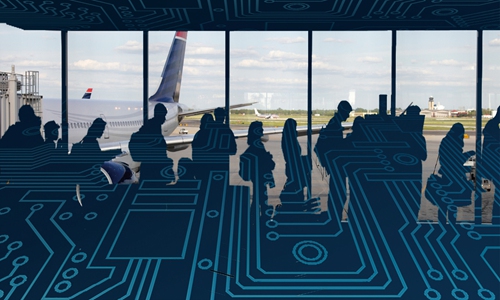SOURCE / PRESS RELEASE
How Huawei is digitally transforming Shenzhen’s airport
From aircraft manufacturing to flight operation and from air traffic management to ground support, services at Shenzhen Bao'an International Airport are about to get smarter with the help of a digital operation makeover.
The CAAC Central and Southern Regional Administration issued guidelines on December 10, supporting the construction of a smart airport in Shenzhen. At the same time, Huawei and Shenzhen Bao'an International Airport jointly released a white paper on the digital transformation smart airport to introduce their efforts to the public.
According to the guidance, the application of new technology will become an important symbol of airport construction and high-quality development, defining the development orientation of Shenzhen's airport to establish a "smart airport benchmark" and build a "new technology application landscape."
The Shenzhen airport will focus on accelerating the renovation and expansion of airport infrastructure, improving the level of comprehensive operation support services, fostering production and service efficiency, and increasing investment in construction. The airport has handled 50 million passengers this year, a historical breakthrough.
The Shenzhen airport digital transformation strategy agreement was signed with Huawei in June 2017, with the vision of making the "best digital experience airport." In light of the agreement, they will carry out digital organization reform, set up a digital management center, and sort out and optimize the business process.
The Civil Aviation Administration of China signed a strategic cooperation agreement with Huawei in May, in which both sides agreed to cooperate in areas such as the top-level design of smart civil aviation, construction of smart civil aviation, promotion of scientific and technological innovation, formulation of standards, and training staff. The agreement also includes cooperative promotion and development of smart civil aviation.
Huang Yige, vice president of the Shenzhen Airport Group Co, said the white paper marks a new phase of the cooperation between the airport and Huawei. "The release of the white paper is expected to provide reference for the construction of smart airports in civil aviation airports across China," Huang said. "During the journey of building a smart airport, I look forward to strengthening cooperation and in-depth exchanges with civil aviation institutions to jointly promote airport construction and high-quality development of civil aviation."
In the past 28 years, the development speed of Shenzhen airport has placed it at the forefront of China, creating the concept of "Shenzhen speed" in domestic civil aviation standards. Serving the Guangdong-Hong Kong-Macao Greater Bay Area and building a world-leading and domestically first-class international aviation hub, the airport is endowed with a new role and mission. In the face of a new round of industrial changes driven by the digital economy, the construction of a smart airport should be used as the driving force to promote high-quality development and improve airport operation efficiency.
"Connection, platform and intelligence" are the three pillars of the small airport's digital transformation. The key to the solution of the digital transformation lies in the integration of new information and communication technology.
President of Huawei China Lu Yong said that in the field of civil aviation, Huawei is committed to building the digital base of a smart airport. "Based on Huawei's digital platform, the comprehensive integration of technology, data and business can be achieved, providing strong support to the industrial digital transformation of the Shenzhen airport."
"We will help the airport realize its three business system under the concept of 'one-map operation', 'one safety network', and 'one-line service,'" he said.

One-map operation
The intelligent operation center can monitor the five major business flows of flights, passengers, luggage, cargo and transportation in real time. The center can also optimize forecasting, early warning, coordinated operation and intelligent decision-making.
Shenzhen airport applies artificial intelligence video analysis technology to ground service operations to monitor any illicit activity, provide an early warning system, timely and accurate forecasts, and improvements to the airport's operation, emergency capacities and passenger service experience.
One safety network
The service operation center can integrate the security system, providing three-dimensional security, integrated fire protection and the establishment of an automatic safety flight area. The center will foster security in the terminals, freight areas, tarmac, and other public spaces.
One-line service
Passengers use face-recognition technology as the only identification in every link of the airport for smooth exit and entry.
Facing the future and based in digital platforms, a smart airport can build a complete passenger portrait, provide business, shopping and other all-round differentiated services, and improve passenger satisfaction.
According to the statistical analysis, the self-queuing face brushing can reduce queuing time by 20 percent, reduce the airport personnel by 50 percent, and improve the efficiency of self-boarding by 40 percent.
The CAAC Central and Southern Regional Administration issued guidelines on December 10, supporting the construction of a smart airport in Shenzhen. At the same time, Huawei and Shenzhen Bao'an International Airport jointly released a white paper on the digital transformation smart airport to introduce their efforts to the public.

People boarding a flight Photo: cnsphoto
According to the guidance, the application of new technology will become an important symbol of airport construction and high-quality development, defining the development orientation of Shenzhen's airport to establish a "smart airport benchmark" and build a "new technology application landscape."
The Shenzhen airport will focus on accelerating the renovation and expansion of airport infrastructure, improving the level of comprehensive operation support services, fostering production and service efficiency, and increasing investment in construction. The airport has handled 50 million passengers this year, a historical breakthrough.
The Shenzhen airport digital transformation strategy agreement was signed with Huawei in June 2017, with the vision of making the "best digital experience airport." In light of the agreement, they will carry out digital organization reform, set up a digital management center, and sort out and optimize the business process.
The Civil Aviation Administration of China signed a strategic cooperation agreement with Huawei in May, in which both sides agreed to cooperate in areas such as the top-level design of smart civil aviation, construction of smart civil aviation, promotion of scientific and technological innovation, formulation of standards, and training staff. The agreement also includes cooperative promotion and development of smart civil aviation.
Huang Yige, vice president of the Shenzhen Airport Group Co, said the white paper marks a new phase of the cooperation between the airport and Huawei. "The release of the white paper is expected to provide reference for the construction of smart airports in civil aviation airports across China," Huang said. "During the journey of building a smart airport, I look forward to strengthening cooperation and in-depth exchanges with civil aviation institutions to jointly promote airport construction and high-quality development of civil aviation."
In the past 28 years, the development speed of Shenzhen airport has placed it at the forefront of China, creating the concept of "Shenzhen speed" in domestic civil aviation standards. Serving the Guangdong-Hong Kong-Macao Greater Bay Area and building a world-leading and domestically first-class international aviation hub, the airport is endowed with a new role and mission. In the face of a new round of industrial changes driven by the digital economy, the construction of a smart airport should be used as the driving force to promote high-quality development and improve airport operation efficiency.
"Connection, platform and intelligence" are the three pillars of the small airport's digital transformation. The key to the solution of the digital transformation lies in the integration of new information and communication technology.
President of Huawei China Lu Yong said that in the field of civil aviation, Huawei is committed to building the digital base of a smart airport. "Based on Huawei's digital platform, the comprehensive integration of technology, data and business can be achieved, providing strong support to the industrial digital transformation of the Shenzhen airport."
"We will help the airport realize its three business system under the concept of 'one-map operation', 'one safety network', and 'one-line service,'" he said.

Photo: cnsphoto
One-map operation
The intelligent operation center can monitor the five major business flows of flights, passengers, luggage, cargo and transportation in real time. The center can also optimize forecasting, early warning, coordinated operation and intelligent decision-making.
Shenzhen airport applies artificial intelligence video analysis technology to ground service operations to monitor any illicit activity, provide an early warning system, timely and accurate forecasts, and improvements to the airport's operation, emergency capacities and passenger service experience.
One safety network
The service operation center can integrate the security system, providing three-dimensional security, integrated fire protection and the establishment of an automatic safety flight area. The center will foster security in the terminals, freight areas, tarmac, and other public spaces.
One-line service
Passengers use face-recognition technology as the only identification in every link of the airport for smooth exit and entry.
Facing the future and based in digital platforms, a smart airport can build a complete passenger portrait, provide business, shopping and other all-round differentiated services, and improve passenger satisfaction.
According to the statistical analysis, the self-queuing face brushing can reduce queuing time by 20 percent, reduce the airport personnel by 50 percent, and improve the efficiency of self-boarding by 40 percent.
